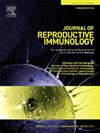孟德尔随机化研究揭示了血浆代谢物、免疫细胞表型和卵巢过度刺激综合征之间的因果关系
IF 2.9
3区 医学
Q3 IMMUNOLOGY
引用次数: 0
摘要
在这项研究中,我们采用孟德尔随机分析法(MR)探讨了免疫细胞表型、血浆代谢物和卵巢过度刺激综合征(OHSS)之间的因果关系。通过对731种免疫细胞表型和1400种血浆代谢物的分析,我们发现了32种与OHSS有因果关系的免疫细胞表型,其中18种表型被确定为保护性因素,14种表型被确定为危险因素。值得注意的是,TCRgd AC表型是与OHSS相关的最重要的风险因素。我们的研究结果还显示,在与OHSS有因果关系的10种血浆代谢物中,3种是保护因素,7种是危险因素。其中,α-酮戊二酸与丙氨酸的比率是最重要的保护性代谢物。进一步研究发现,EM DN(CD4-CD8-)AC免疫细胞表型与α-酮戊二酸与丙氨酸比率之间存在因果关系。反向 MR 分析表明,OHSS 会影响骨髓 OC 细胞上 HLA-DR 的表达。中介分析表明,α-酮戊二酸与丙氨酸的比率在免疫细胞到OHSS的途径中具有不显著的中介效应,占总效应的-8.68%。总之,我们的研究结果强调了特定免疫细胞表型和血浆代谢物在OHSS发病机制中的作用,揭示了旨在降低OHSS风险的潜在干预目标。本文章由计算机程序翻译,如有差异,请以英文原文为准。
Mendelian randomization study reveals causal associations between plasma metabolites, immune cell phenotypes, and ovarian hyperstimulation syndrome
In this study, we employed Mendelian randomization (MR) analysis to explore the causal relationships between immune cell phenotypes, plasma metabolites, and ovarian hyperstimulation syndrome (OHSS). Through the analysis of 731 immune cell phenotypes and 1400 plasma metabolites, we identified 32 immune cell phenotypes that are causally related to OHSS, with 18 phenotypes identified as protective and 14 as risk factors. Notably, the TCRgd AC phenotype was the most significant risk factor associated with OHSS. Our findings also revealed that among the 10 plasma metabolites causally linked to OHSS, three acted as protective factors, while seven were identified as risk factors. The Alpha-ketoglutarate to alanine ratio stood out as the most significant protective metabolite. Further investigation established a causal link between the EM DN (CD4-CD8-) AC immune cell phenotype and the Alpha-ketoglutarate to alanine ratio. Reverse MR analysis indicated that OHSS influences the expression of HLA-DR on myeloid OC cells. Mediation analysis suggested a non-significant mediation effect of the Alpha-ketoglutarate to alanine ratio in the pathway from immune cells to OHSS, accounting for −8.68 % of the total effect. Collectively, our results underscore the role of specific immune cell phenotypes and plasma metabolites in the pathogenesis of OHSS, revealing potential targets for developing interventions aimed at reducing the risk of OHSS.
求助全文
通过发布文献求助,成功后即可免费获取论文全文。
去求助
来源期刊
CiteScore
6.30
自引率
5.90%
发文量
162
审稿时长
10.6 weeks
期刊介绍:
Affiliated with the European Society of Reproductive Immunology and with the International Society for Immunology of Reproduction
The aim of the Journal of Reproductive Immunology is to provide the critical forum for the dissemination of results from high quality research in all aspects of experimental, animal and clinical reproductive immunobiology.
This encompasses normal and pathological processes of:
* Male and Female Reproductive Tracts
* Gametogenesis and Embryogenesis
* Implantation and Placental Development
* Gestation and Parturition
* Mammary Gland and Lactation.

 求助内容:
求助内容: 应助结果提醒方式:
应助结果提醒方式:


